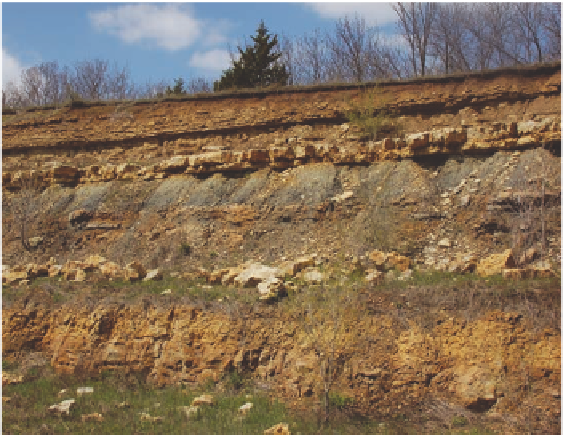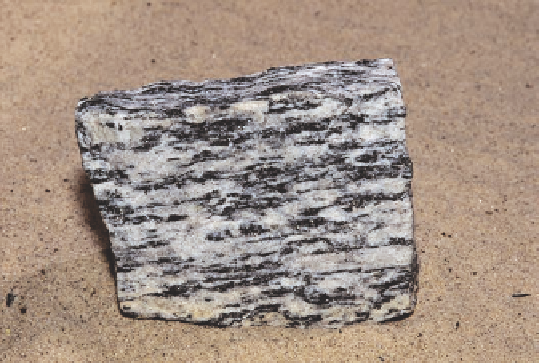Geoscience Reference
In-Depth Information
(a)
(b)
Figure 12.17 Some metamorphic rocks.
(a) Schist forms when the metamorphic rock slate is further altered. (b) Gneiss evolves when
igneous or sedimentary rocks are dramatically heated. Note the banding in this rock where minerals aligned under the intense heat.
takes place, the result is that mineral components within the
rock are rearranged to form different mineral varieties, or the
minerals recrystallize into new mineral forms.
Although many different kinds of metamorphic rocks
occur, just a few will be described here.
Slate
forms when
shale is heated and compressed, forming a grayish, smooth
rock that is quite hard. You may be familiar with slate be-
cause it is used as roofing shingles, patio flagstones, chalk-
boards, and the surface of the best pool tables. When slate
is further heated and compressed, so that distinct planes and
coarse texture develop, it becomes
schist
(Figure 12.17a).
Limestone that has undergone metamorphism becomes
marble
, which has a distinctive appearance because min-
eral impurities show up as swirling bands. Marble is popular
because it is frequently used in expensive tabletops and
flooring. Finally,
gneiss
is a hard, banded metamorphic rock
(Figure 12.17b) that forms when igneous or sedimentary
rocks have been in close contact with intrusive magmas. The
banding occurs because minerals become aligned during the
metamorphic process. These kinds of rocks are described as
being
foliated
, whereas those that lack banding are
nonfoli-
ated
(Figure 12.17a).
The Rock Cycle
Recall from earlier chapters that water and carbon move from one
reservoir on Earth to others as part of the hydrologic and carbon
cycles, respectively. In a similar way, minerals contained within
VISUAL CONCEPT CHECK
12.2
This image shows rock outcrop along a
highway. The lower arrow points to a shale
bed, whereas the upper arrow focuses on a
limestone rock unit. Which one of the follow-
ing choices best explains this combination
of rocks?
a)
They are igneous rocks.
b)
They were modified by intense heat and
pressure.
c)
These units reflect fluctuating sea levels
in the past.
d)
They formed when sandy sediments
accumulated along a beach.






